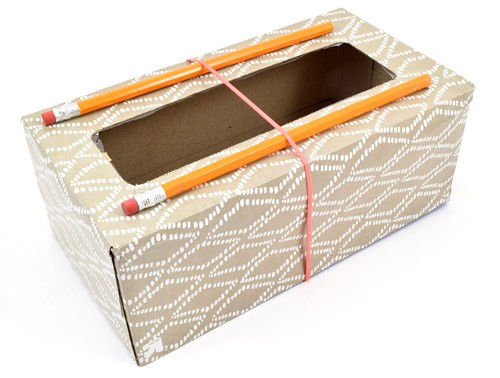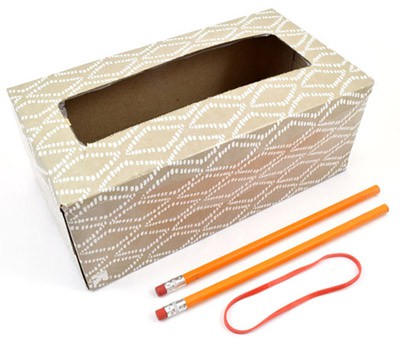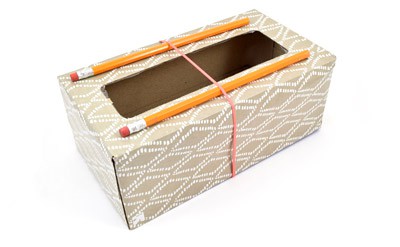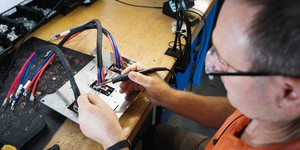Summary
 Image Credit: Ben Finio, Science Buddies / Science Buddies
Image Credit: Ben Finio, Science Buddies / Science Buddies
Introduction
Did you know that the modern guitar is an instrument that dates back over 4,000 years? The first guitar music was published in 1546, during a time when guitars still had strings made from animal intestines! While guitars have a long history, they are still extremely popular in modern day music. Have you ever wondered how they make the music you listen to everyday? In this activity we're going to make our own guitars, and experiment with the different sounds we can create.Materials
- Long tissue box with single hole in the top
- Assorted rubber bands
- Pencils or pens (2)
 Image Credit: Ben Finio, Science Buddies / Science Buddies
Image Credit: Ben Finio, Science Buddies / Science Buddies
Prep Work
Instructions
- Wrap a rubber band around the tissue box so it goes across the hole. Whether you do this length-wise or width-wise depends on the size of your rubber band.
- Slide the two pencils under the rubber band, on one each side of the hole.
 Image Credit: Ben Finio, Science Buddies / Science Buddies
Image Credit: Ben Finio, Science Buddies / Science Buddies
- Pluck the rubber band with your finger.What do you hear?
- Try adding rubber bands of different lengths and/or thicknesses to your guitar. Pluck them.Do they sound different?
- After you pluck a rubber band, touch it with your finger to make it stop vibrating.What happens?
- Try moving the pencils closer together or farther apart.How does this change the sound?
What Happened?
When you plucked the rubber band, you made it vibrate. This caused the nearby air molecules to vibrate, creating a sound wave that traveled to your ear. Your brain interpreted these vibrations and you heard the sound. The pitch (highness or lowness) of the sound a rubber band makes depends on several factors. Read the Digging Deeper section to learn more.Digging Deeper
All sounds are caused by vibrations, or rapid back-and-forth motions of an object. These vibrations can transfer to nearby molecules (usually air, but sounds can also travel through liquids and solids) and ultimately reach our ears. The frequency of the vibration, or number of vibrations per second, determines the pitch that we hear. Frequency is measured in hertz (Hz). One hertz equals one vibration per second. Human hearing is typically in the range of 20 Hz up to 20,000 Hz. Some animals, like dogs, can hear up to around 45,000 Hz!
The frequency of a sound depends on several factors. In general, smaller, lighter things will make higher-frequency sounds than bigger, heavier things. This is why children generally have higher-pitched voices than adults. The pitch of the rubber bands in your guitar depends on how thick they are, how tightly they are stretched, and the length of the vibrating section between the pencils. The thinner the rubber band, the tighter it is stretched, and the shorter the length of the vibrating section, the higher the pitch will be. By carefully manipulating these variables (for example, using rubber bands that are all the same length, but different thickness) you can create a rubber band guitar with multiple "strings" that each have a different pitch.
These concepts all apply to real guitars (and other instruments) as well. If you look at a real guitar you will notice that the strings are not all the same thickness. Thicker strings have a lower pitch. If you press down on a string partway along its length, you shorten the vibrating section, increasing the pitch. This allows you to play a wide range of frequencies with just a few strings.
Ask an Expert
For Further Exploration
- Try using different size boxes or changing the size of the hole in the box. How does this affect the sound?
Related Resources
Lesson Plans
- 1-PS4-1. Plan and conduct investigations to provide evidence that vibrating materials can make sound and that sound can make materials vibrate.










